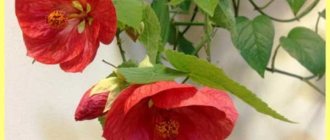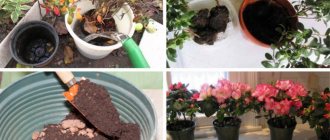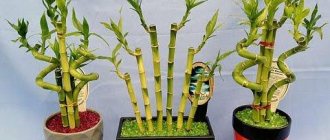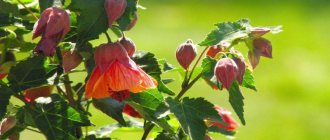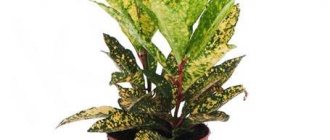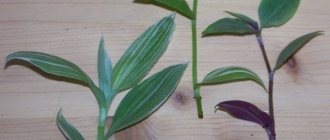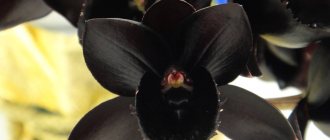In its natural habitat (tropics and subtropics), abutilon or ropewort is found everywhere in the wild, but in harsher climates it is grown exclusively as a decorative potted crop. Its advantages are the original shape of the leaves, for which it is called “indoor maple,” delicate bell-shaped buds, rapid growth and long-lasting flowering, up to six months or more. At the same time, caring for abutilone is very simple. Even a novice gardener can grow a healthy and beautiful plant, even if only briefly knowing how to care for it.
Features of caring for abutilone at home
To grow abutilone at home, preference should be given to hybrid varieties. They are distinguished by their compact crown and large flower sizes. In order for bright bells to bloom on your home maple from spring to late autumn, you need to comply with lighting conditions, temperature conditions, watering and fertilize on time.
Air temperature
Despite the fact that the abutilon maple is a southern plant, being constantly in a warm apartment is not good for it. The ideal temperature for a tropical “guest” in the warm season is +20 °C – +26 °C, and in winter it should be at +12 °C – +15 °C.
If the air cools to +5 °C - +10 °C, abutilon may begin to shed its leaves. Drafts pose no less danger to him. Too warm air can also negatively affect the condition of indoor maple. At a temperature of +30 °C, the formation of buds stops. To help the green pet, they resort to spraying the above-ground parts with warm, soft, settled water.
On summer days, abutilon responds well to being on a sunny veranda or balcony, and sometimes plants are successfully transferred to the garden or even transplanted into open ground.
Lighting
Abutilones are photophilous and need bright, diffused light. Its deficiency leads to a decrease in the number of buds on the bush. In this case, varieties with variegated (variegated) or light-colored leaves are slightly shaded. This helps maintain beautiful, clear patterns on them.
Abutilons on the windowsill in the apartment
Preferred places for growing indoor maple abutilon, which takes place in the house, are eastern, western, south-eastern and south-western window sills. Bushes located on the south side must be protected from the sun during the midday hours, otherwise their leaves will dry out. Plants placed on the windowsills of northern windows need additional lighting.
Watering
Abutilons love plenty of watering. Do not allow the soil in the pot to dry out. The need for moisture increases in hot weather or during cold periods when heaters are running in the apartment or the heating system is turned on. Timely watering is especially important during the growing season. Lack of moisture in this case inevitably leads to wilting, loss of buds, and sometimes to the death of the root system.
If abutilone lacks moisture, it begins to actively shed buds. Overwatering may be indicated by the drooping appearance of the plant.
You need to water your home maple tree at the moment when the soil dries out slightly after the previous watering. For this you should use settled or melted warm water. During cold wintering, the amount and abundance of watering is significantly reduced to prevent the appearance of rot.
Soil selection
The soil for home maple should be well permeable to air and moisture. This can be a universal soil intended for indoor plants with the addition of sand, vermiculite or perlite. The substrate for abutilone should not only be loose and light, but also have a neutral or slightly acidic pH reaction (within 6-7), and also be moisture- and breathable.
If you make the soil yourself, you will need to mix: 2 parts turf soil, 2 parts coniferous or deciduous humus, 0.5 parts river sand, 1 part coconut substrate. For drainage at the bottom of the pot (about 2 centimeters), it is recommended to use expanded clay or just small pebbles, as well as sphagnum moss (it is laid on top of the expanded clay before pouring the soil mixture, to create additional moisture exchange).
Feeding
Abutilon grows very quickly and is generally quite “voracious” for these reasons it needs constant feeding. They are applied from the onset of spring until autumn every two weeks. The abundance and quality of flowering depends on the regularity of fertilizing. It is recommended to alternate the application of mineral fertilizers with the addition of organic matter to the soil.
The concentration of fertilizers for abutilone may be less than in the instructions for the selected composition, but the flower needs to be fed a little more often. During the time of mass flowering, it is better to fertilize abutilon with products with a high content of phosphorus and potassium, which have a positive effect on the formation of buds. When, after pruning, abutilon must quickly grow new foliage, it is more correct to use preparations with nitrogen.
A lack of mineral fertilizers often leads to the fact that the leaves of abutilone begin to turn yellow; in this case, a drug called “Emerald” will help.
Briefly about cultivation
- Flowering: from April to November.
- Lighting: bright light or light partial shade.
- Temperature: during the growing season – about 25 ºC, in winter – 12-15 ºC.
- Watering: from early March to autumn - abundant; in winter, the top layer of the substrate should dry out to a quarter of the depth between waterings.
- Air humidity: high, regular spraying of leaves is required.
- Feeding: during the period of growth and flowering - once every two weeks with mineral or organic fertilizers.
- Dormant period: not clearly expressed, but from November to March all processes in the plant slow down.
- Transplantation: in the spring, before active growth begins: young plants are replanted annually, adults - once every 3 years.
- Substrate: neutral or slightly acidic (about 6 pH). Composition: 1 part leaf soil, 1 part humus and half sand.
- Reproduction: seeds and cuttings.
- Pests: thrips, spider mites, mealybugs, scale insects, aphids and whiteflies.
- Diseases: with improper care - root rot, leaf drop.
Read more about growing abutilone below.
How to care for abutilone in winter
Winter maintenance of the “southern guest” involves two options: warm and cold wintering.
Warm wintering
When keeping abutilone in a house on a windowsill in winter at temperatures from +18 °C to +22 °C, it is necessary to provide it with additional lighting. Several 20 W lamps are suitable for this.
The root system of indoor maple can be subject to hypothermia and rot. To protect the roots, you can place insulating material under the flower pot, such as a cork stand or a piece of foam.
Watering the abutilon should be moderate and should be done after half the pot has dried out the soil. Feeding is done leaf by leaf and only when signs of nutrient deficiency occur.
Cold winter
At home, a balcony or loggia can become a place for cold wintering of abutilon, but with one important condition: the air temperature should not fall below +8 °C. Watering should be moderate, closer to meager. It is carried out after the soil has dried out as much as possible. Fertilizers are not applied in winter until mid-February. It is better to choose soil for cold wintering that is breathable, loose and light.
In winter, when the air quality in the room is affected by heating devices, a screen made of non-woven material or film, separating the space under the window sill from the living space, will be a good protection from the heat.
Reproduction methods
To propagate abutilon, they resort to the seed method, and also use low-lignified cuttings.
Growing from seeds
Seeds are sown at the beginning of spring, using a soil mixture that should include peat and sand. They are buried only half a centimeter. Crops need to be provided with daily ventilation and spraying; they are placed in a relatively warm place (from 16 to 20 degrees). The first seedlings should appear in about 20 days. When growing abutilone from seeds, it should be taken into account that seedlings exhibit splitting of parental characteristics. In this regard, seed propagation is not suitable for variegated varieties.
Abutilon: from sowing to flowering 2 months!
Propagation of abutilone by cuttings
This plant can be propagated by cuttings in the spring. To cut cuttings, use the tips of young shoots; each segment should have 3 leaf plates, and their length can vary from 10 to 12 centimeters. They need to be cut off all the buds and then planted in a soil mixture consisting of sand and peat, which should be kept moist all the time. In this case, cuttings can be rooted in water at a temperature of 21 to 23 degrees for 30 days. To make the cuttings take root faster, you need to make a mini-greenhouse. After rooting, the cuttings are planted in pots up to 70 mm in diameter. As cuttings, you can use sections of stems that remain after pruning.
Fertilizers for abutilone
Indoor maple loves feeding and responds gratefully to it. At the same time, almost any composition is suitable for it. It makes sense to apply fertilizers for abutilone from the onset of spring until autumn, and experienced gardeners recommend diluting them in a slightly lower concentration than suggested in the instructions for the selected composition. Fertilizing ends in October.
When the time for active flowering comes, the bush is fertilized with products saturated with potassium and fluorine. They promote the formation of buds. After pruning branches and during the period of active growth of green mass, it is useful to apply nitrogen-containing preparations. And when it becomes discolored, signaling a deficiency of microelements, the plant is fed with complex organomineral fertilizer, for example, “Emerald”.
In summer, you can reduce the intervals for fertilizing the soil to once every 2 weeks. From about November until spring, it is enough to feed the substrate once a month or stop feeding altogether so that the plant can rest.
Home maple abutilon: watering
Water abutilon abundantly, but do not allow water to stagnate. Water for irrigation should be at room temperature, soft (pH 5.0). During periods of intensive growth and high air temperatures, plants have a very high need for moisture. Overdrying of the earthen clod leads to the shedding of leaves and buds. It is advisable to regularly spray the leaves with boiled water - it does not leave white spots. You need to water your home maple tree when the soil dries out a little on top. In winter, watering is reduced. Water moderately as the soil dries.
Important!!!
Water the flower only with warm water or water at room temperature. Melt water is suitable for irrigation.
Abutilone diseases
If the green “pet” is cared for in a timely and correct manner, nothing threatens it. If not properly cared for, indoor maple can be exposed to diseases and pests. Symptoms and reasons for their appearance may be different, as well as ways to help the flower.
Flowering problems
The first buds bloom on it 3-5 months after sowing the seeds. But sometimes all the permissible deadlines pass, and the home maple does not bloom. This means that he does not have enough strength to set and open the buds.
There are two main reasons why abutilon does not bloom:
- lack of lighting (the plant requires at least 2 hours of bright sunlight per day);
- excessively large volume of the flower pot: the bush spends too much effort filling it with the root system.
Sometimes abutilone drops its buds. Possible reasons for this phenomenon:
- insufficient watering, especially in spring and summer;
- nutrient deficiency, need for additional feeding;
- exposure to drafts; indoor maple does not tolerate them.
Problems with leaves
If the leaves of indoor maple are not properly cared for, problems of different nature and varying degrees of complexity can also arise. Each of them needs to be addressed individually:
- Abutilone sheds its leaves, they turn yellow and fall off. In some varieties, this indicates the onset of a dormant period in winter. Also, the reason may lie in damage to the root system or lack of nutrition.
- Abutilone leaves curl. The flower may be exposed to direct sunlight, the air humidity may be too low, and the temperature may be too high. To help him, it is worth trying to change the conditions of his detention.
- The lower leaves turn yellow. The reasons may be related to a lack of light or fertilizing. The flower pot should be moved to a more illuminated place, complex fertilizer should be applied, and the bush should also be inspected for the presence of pests, for example, spider mites.
- Leaves are lighter than usual. This is due to insufficient frequency of watering, lack of microelements, lack of sunlight and fresh air. To help the flower, you should water it more often, but with less water, move the pot to a brighter, ventilated room and feed it with complex fertilizer.
- Rust spots on green material. This is the result of infection by rust fungi. To combat the disease, affected leaves and shoots are removed. The bush is sprayed with the systemic fungicide Topaz, which is effective not only against rust, but also powdery mildew, spores and mycelium of pathogenic fungi. It can also be used for prevention: spray the flower at the beginning of the growing season.
Types of abutilone with photos and names
Abutilon vitifolium
The height of this shrub is about 250 cm. Its stems are softly pubescent. Green, velvety large leaf blades are 3–5 lobed, their edge is clearly serrated, and their length is about 15 centimeters. The flowers are located on pedicels, which reach a length of about 15 centimeters; they are collected in 3 or 4 pieces in a brush. The corolla can be broadly bell-shaped or wheel-shaped, almost round. On the surface of bluish-lilac flowers there are sometimes veins of a darker shade. This species blooms in May.
Abutilon hybridum
The hybrid abutilon pictum, created by American breeders, which is also called Darwin abutilon (Abutilon darwinii) or striped abutilon (Abutilon striatum), has many different varieties. The evergreen shrub reaches a height of about 150 cm, its shoots are covered with brown bark. The 3–5 lobed leaf blades are green, softly pubescent, maple-shaped, long-petiolate, and about 12 centimeters long. The color of the bell-shaped drooping flowers, depending on the variety, can be golden, dark red, white or red; they reach a length of about 50 mm.
Darwin's Abutilon (Abutilon darwinii = hildenbrandii)
This shrub is very rarely cultivated. The length of the silky pubescent stems is about 100 cm. At their tops there are large three-lobed, long-petioled, drooping leaf plates, their width is from 8 to 10 centimeters, and their length is from 15 to 20 centimeters. 5–7 lobed leaf plates grow below, with the central one elongated. In the leaf axils, 1–3 rich orange bell-shaped flowers with red veins are formed; they reach about 50 mm in diameter. Flowering of this species is observed in April–September.
Megapotamian abutilon (Abutilon megapotmicum), or Amazonian abutilon
In England, this species is called Weeping Chinese Lantern, or “weeping Chinese lantern.” The height of the bush is about 150 cm, its stems are thin and drooping. The bright green, elongated oval leaf blades are sometimes irregularly toothed and are about 80 mm long. Single flowers hang on fairly long stalks with a convex corolla of tubular-ribbed shape, usually deep red. The calyx consists of yellowish petals, at the base of which there is a red spot. If you care for the bush correctly, it will bloom all year long.
Spotted abutilon (Abutilon pictum), or painted abutilon (Abutilon striatum), or striped abutilon
This is a shrub with soft, short, practically non-woody stems. Heart-shaped, long-petiolate green leaf blades have 3–6 lobes, serrate along the edge, they are not pubescent, and there are torn white spots along the edges. Bell-shaped flowers grow in the leaf axils on long stalks; their corolla is golden with red veins and is several times longer than the calyx. Flowering occurs in August–September. This species has a variety of thompsonii Vetch: the height of the bush is about 200 cm, the jagged bare five-lobed leaf plates reach about 10 centimeters in length, the dark green base of the plate has yellow spots, large flowers with a diameter of about 70 mm are double or simple yellow or reddish, flowering is observed in June.
Abutilon sellowianum
Some gardeners confuse this species with hybrid abutilon, but this shrub is weakly branched and its height is about 200 cm. There is pubescence on the surface of the straight stems. Trifoliate leaf blades have elongated pointed lobes. The surface of the lavender flowers has pink veins. Flowering begins in July and ends in mid-December.
Abutilone Marmoratum
It differs from other species in that it has golden-pinnate striped leaf plates. Its stems are graceful and long, so this species is cultivated as a hanging plant, and it is also grown in the winter garden as a ground cover crop.
Pests of abutilons
Indoor maples are disease resistant. But it can be attacked by insects and other pests. Bushes are most vulnerable in the spring, when parasites are actively multiplying, and the immunity of green pets is weakened after wintering and cannot fully resist them.
The main pests of abutilone:
- Scale insects. When they appear, abutilon becomes covered with sticky secretions, and then with small brown plaques. To remove pests, you can use a cotton pad and treat the bush with an insecticide solution, for example, actara or soap solution.
- Spider mites. Signs of their presence in a pot with a plant are the presence of gray or black specks on the inner surface of the leaves, as well as thin cobwebs. You can cope with this pest using agrovertin or fitoverm. The treatment must be carried out several times, with a week break.
- Aphid. Causes considerable harm to rope riders and infects them with viral diseases. When aphids appear, you can use an agrovertine solution or use folk remedies. For example, once a week it is allowed to treat the bush with an infusion of garlic and laundry soap.
Possible problems when growing abutilone
If proper attention is not paid to the care of abutilone, the gardener may encounter the appearance of dangerous diseases and pests such as root rot, mealybugs, aphids, spider mites and scale insects. For prevention, be sure to maintain proper watering, humidify the air and remove fallen flowers and leaves.
Shedding of buds, yellowing and wilting of abutilon foliage signals:
- about sudden changes in temperature of abutilone content;
- about the presence of a draft in the room;
- about violation of the watering schedule.
The appearance of the plant and its flowering are not best affected by the lack of light and the lack of fertilizers when they are especially needed - during the spring and summer growing season.
How to trim abutilon
Indoor maple at home can grow up to 1.5 meters in height. Without pruning, it loses its shape, the inflorescences are located only at the ends of the shoots. To form a compact bush or standard tree, it is necessary to prune the shoots in spring and autumn, leaving half or a third of their original length. Abutilon feels comfortable after pruning and pinching, completely restoring the volume of green mass in a few weeks.
To form a compact bush or standard tree, pruning is indispensable. Shoots are cut and pinched in autumn and spring to half or a third of their original length.
In order for abutilon to bush well, dried and damaged branches should be regularly cut off from a faded bush and the crown should be thinned out. And in the spring, adjustments to the crown shape must be repeated. Thanks to pruning, dormant buds awaken and side branches appear. After this procedure, the plant must be fed. When forming a trunk, to give the plant stability so that the bush does not droop its branches, it is recommended to install supports.
All articles about abutilones on the site can be read by following this link...
The abutilon flower is the dream of many home flora lovers. This potted plant combines ease of care, unpretentiousness and high decorativeness. Pay attention to the green “pet” and every year, from spring to late autumn, it will delight you with abundant and colorful flowering.
Conditions required for indoor maple
The tropical guest abutilon has firmly established itself in the home collections of Russian flower growers. As experts on this plant say, any spacious window sill with a lot of sun is a suitable place for a home maple tree. Plus it requires plenty of hydration and nutrition.
Table: conditions for indoor maple depending on the season (spring-summer/autumn-winter)
| Season | Lighting | Humidity | Content temperature |
| Spring Summer | Abutilone is light-loving, but it needs to be shaded from bright sunlight. With the onset of warm days, it is best to take the tub with the plant out onto the balcony or place it in the garden in a semi-shaded place. In the room, the ideal option would be to be located near a window with an east or west orientation. | Humidity is not critical. In hot weather, daily spraying with warm water can be done. | +22–25 °C |
| Autumn winter | A very bright place is required, since in winter the plant suffers from a lack of sunlight. A window facing south is perfect. It is also necessary to supplement the abutilon with fluorescent lamps. | Spraying is required when the indoor air is too dry. If the temperature is less than +18°C, the procedure should be stopped completely. | +14–16 °C |
Reproduction and planting technologies
Abutilone propagates in two ways: seeds and cuttings. After pruning the plant, a large number of cuttings appear that can be rooted. However, indoor maple can also be grown from seeds.
Cuttings
When wondering how to propagate rope plant while maintaining all the characteristics of an adult plant, cuttings are optimal, which can be used for any variety of abutilon.
In this propagation method, cuttings are used only from the top of the flower. Their length should be no more than 15 cm and have 3-4 leaves and buds. If there is a bud on it, then it must be cut off so that the plant can take root faster.
Important! Abutilon cuttings are planted in the spring so that by summer the plant becomes stronger and can delight you with lush greenery and flowering.
After cutting, the shoot does not need special treatment and can be immediately placed in a separate tall glass with moist soil. In order for it to take root well, greenhouse conditions are artificially created for it.
In this case, it is necessary to constantly maintain moist soil and air, provide a sufficient amount of light and an air temperature of +25ºС. If all conditions are met, then after 2 weeks the cuttings will take root and can be transplanted into a small pot.
If necessary, the flower is transplanted into a larger pot. These plants are cared for in the same way as adults.
Seeds
This method does not require special skills and is quite simple. The seeds need to be prepared first. To do this, they are sorted out and only the largest ones are left, after which they are soaked in water.
If some of them float to the surface, then these seeds must be selected, since they cannot be used for planting, because the germination rate will be very low.
Important! Hybrid varieties of abutilone cannot be grown from seeds, since the main characteristics of the mother plant will be lost.
A container with a mixture of peat soil and sand is ideal for sowing seeds. It is necessary to sow seeds to a depth of no more than 8 mm and no less than 5. After sowing, the soil is well moistened and covered with a lid or special film, thus creating a greenhouse effect.
The temperature must be maintained within +22…+28ºС. The container with the seeds is placed in a well-lit place. To prevent the air from stagnating in the minigreenhouse, it must be periodically ventilated and the soil must be moistened, if necessary, by spraying.
20–35 days after planting, the first shoots hatch. Plants can be replanted only when the sprouts have 3-4 leaves. The pots are changed gradually; in the first year you can replant the flower up to 4 times.
Plants grown in this way begin to bloom within 3-4 months from the moment of planting.
Temperature
Despite the fact that Abution loves light, it should not be kept in a warm room all the time. In its homeland, domestic maple grew in regions with a temperature regime of + 10 ⁰С. Therefore, the cable car is a frequent guest of winter gardens and greenhouses.
The plant should be kept at home:
- In summer at a temperature of 20-26°C;
- In winter at a temperature of 12-15°C.
In winter, abutilone is kept in a bright, cool room. During a warmer winter, its leaves dry out and fall off. In cool air, the flower transforms and turns green.
At temperatures below 5°C, the abutilon maple sheds its leaves. Stops the formation of buds. Doesn't bloom. But not only cold temperatures and drafts are dangerous for the plant. The ropewort does not tolerate heat when the air temperature reaches 30 °C. At this temperature, domestic maple suffers. Sheds leaves and does not bloom. In such a situation, the indoor flower will be helped by regular spraying, which is done with soft or boiled water.
Heating appliances are harmful to abutilone. So that they cause less harm to the plant, construct a screen of film or fabric. It protects and protects the flower from drying out.
